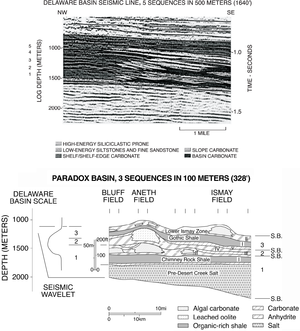Difference between revisions of "Seismic scale importance"
(→See also: moved) |
(links; clear before see also) |
||
| Line 16: | Line 16: | ||
==Scale and data type== | ==Scale and data type== | ||
| − | |||
[[file:exploring-for-stratigraphic-traps_fig21-4.png|left|thumb|{{figure number|1}}. Copyright: Sarg, 1988; courtesy SEPM.]] | [[file:exploring-for-stratigraphic-traps_fig21-4.png|left|thumb|{{figure number|1}}. Copyright: Sarg, 1988; courtesy SEPM.]] | ||
| Line 22: | Line 21: | ||
==Scale and trap detection== | ==Scale and trap detection== | ||
| − | Scale makes a difference in ease of detection and, hence, affects risk. In [[:file:exploring-for-stratigraphic-traps_fig21-4.png|Figure 1]], Pennsylvanian carbonate reef margin depositional sequences from the Delaware and Paradox | + | Scale makes a difference in ease of detection and, hence, affects risk. In [[:file:exploring-for-stratigraphic-traps_fig21-4.png|Figure 1]], Pennsylvanian ({{Ma|Pennsylvanian}}) carbonate reef margin depositional sequences from the [[Delaware basin|Delaware]] and [[Paradox basin]]s, U.S.A., are compared. Note the difference in scale and how it affects [[seismic interpretation]]. Seismic detection of the Paradox basin traps is much more difficult because of the wavelength of the seismic wave vs. the reservoir thickness. |
| + | {{clear}} | ||
==See also== | ==See also== | ||
* [[Stratigraphic trap]]s | * [[Stratigraphic trap]]s | ||
Revision as of 19:52, 22 January 2014
| Exploring for Oil and Gas Traps | |

| |
| Series | Treatise in Petroleum Geology |
|---|---|
| Part | Predicting the occurrence of oil and gas traps |
| Chapter | Exploring for stratigraphic traps |
| Author | John C. Dolson, Mike S. Bahorich, Rick C. Tobin, Edward A. Beaumont, Louis J. Terlikoski, Michael L. Hendricks |
| Link | Web page |
| Store | AAPG Store |
Scale and data type
Correlations with well data, such as cuttings, cores, or well logs, can be done to a much higher resolution than seismic scale correlations. The scale of a seismic wavelet limits the scale of correlations within a seismic section. The geologist must refine these correlations to a higher resolution using well data to more accurately define the location of seals and reservoirs.
Scale and trap detection
Scale makes a difference in ease of detection and, hence, affects risk. In Figure 1, Pennsylvanian (323.2 Ma) carbonate reef margin depositional sequences from the Delaware and Paradox basins, U.S.A., are compared. Note the difference in scale and how it affects seismic interpretation. Seismic detection of the Paradox basin traps is much more difficult because of the wavelength of the seismic wave vs. the reservoir thickness.
See also
- Stratigraphic traps
- Exploring for stratigraphic traps
- Importance of stratigraphic trap seals
- Impact of diagenesis
